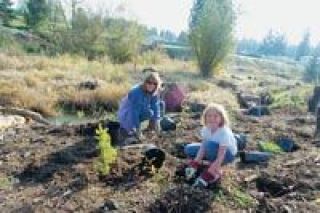MARYSVILLE It was a girls day out last weekend at the 10th Annual Save Our Waves event, where more than 200 Girl Scouts from Snohomish County plucked and planted the banks of the middle fork of Quilceda Creek.
Scouts from the Marysville area planted 16,000 trees and shrubs in a four-acre plot straddling the creek, a home for Chinook salmon and bull trout; the middle fork is the most productive branch of The Quil, and the pre-teens were taking action to make the brook a fish-friendly place once again.
Meadowcreek Park is a greenbelt created around the salmon-bearing stream by two housing developments near Shoultes Elementary School years ago. Over two decades the stream running through the park has become clogged with invasive species such as blackberry bushes and deadly nightshade, also known as belladonna. Those shrubs crowd out other vegetation and can harm streams like the Quil. The scouts from the Marysville area got their hands dirty planting several different species of plants to help keep the water clean and cool.
Weve been pulling out a lot of these things, said Girl Scout Franqui Rojas, holding a blackberry stump with stems a couple of inches around and a huge root ball the size of a softball. The 11-year-old was working with members of her troop on the west bank, where Sarah Hoot, Tiffany Grande and Courtney Miller had given names to the plants they were pulling from their containers and putting into the ground. A favorite spruce was called Jackie Robinson after the baseball pioneer; it was joined by another called Timbuktu, one known as Junior and Chub the Shrub. Believe it or not, they were getting a lot accomplished while getting schooled on fish.
We learned that it helps the environment, Hoot explained.
And that it helps keep the water clean and gives us oxygen to breathe, Rojas added.
As they dug up the berry bushes by the root and stem they replaced them with Sitka spruce, Nootka rose, Ninebark, Western Red Cedar and hemlock plants, in addition to some alder trees. According to workers from the Snohomish County Surface Water Management, these plants play well together, giving each other the space, air and light they all need to survive. That also includes keeping the stream clear of detritus and covered so the sun doesnt bake the salmon before their time; a difference of only five degrees water temperature can result from inadequate tree cover and thats not good according to a county worker.
Jackie Gauthier is a surface water specialist who noted that the native plants the scouts were planting put nutrients back into the soils and harbor the insects that fish eat; the unwanted plants dont do either. She added that leaf litter from the good trees provides ground cover and filters water as it runs along the ground and alders add nitrogen to the soil. But they have to be put into the ground to do any good.
Were so pleased because we have so many plants to be planted, Gauthier said. Most of the larger trees were bare root plants in two-gallon pots, she explained. The county grows them in house, with as many as 45,000 on-hand at peak times.
So every year we basically clean out the nursery, Gauthier laughed.
This is the 10th year the scouts have contributed the elbow grease to compliment the countys plants. Last year the scouts cleaned and replanted Grace Creek just north of Cedarcrest Golf Course in Marysville, conducting sampling studies to observe the health of that streams critters. This year the emphasis was on work, and lots of it.
Last year we had about 60 people and today weve got about 200, so its a big improvement, Rojas said.
Save Our Waves was funded by a $45,000 grant from the Community Salmon Fund and is administered through the countys native plant program. Before the scouts hit the creek side, workers installed snags of downed trees to re-create the meanders found in nature. As the newly planted trees grow and die, they will fall into the stream in decades to come, providing the pools, eddies and hiding a resting places for fish and their food chain, said Janet Carroll of Snohomish County Surface Water Management.
Save Our Waves – Mville troops clean and plant middle fork of Quilceda Creek
MARYSVILLE It was a girls day out last weekend at the 10th Annual Save Our Waves event, where more than 200 Girl Scouts from Snohomish County plucked and planted the banks of the middle fork of Quilceda Creek.



